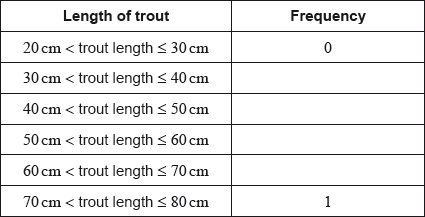| Date | May 2022 | Marks available | 1 | Reference code | 22M.2.SL.TZ2.1 |
| Level | Standard Level | Paper | Paper 2 | Time zone | Time zone 2 |
| Command term | Write down | Question number | 1 | Adapted from | N/A |
Question
Mackenzie conducted an experiment on the reaction times of teenagers. The results of the experiment are displayed in the following cumulative frequency graph.
Use the graph to estimate the
Mackenzie created the cumulative frequency graph using the following grouped frequency table.
Upon completion of the experiment, Mackenzie realized that some values were grouped incorrectly in the frequency table. Some reaction times recorded in the interval should have been recorded in the interval .
median reaction time.
interquartile range of the reaction times.
Find the estimated number of teenagers who have a reaction time greater than seconds.
Determine the percentile of the reaction times from the cumulative frequency graph.
Write down the value of .
Write down the value of .
Write down the modal class from the table.
Use your graphic display calculator to find an estimate of the mean reaction time.
Suggest how, if at all, the estimated mean and estimated median reaction times will change if the errors are corrected. Justify your response.
Markscheme
A1
[1 mark]
(A1)(M1)
Note: Award A1 for correct quartiles seen, M1 for subtraction of their quartiles.
A1
[3 marks]
(people have reaction time ) (A1)
(people have reaction time ) A1
[2 marks]
OR (A1)
A1
[2 marks]
A1
[1 mark]
A1
[1 mark]
A1
[1 mark]
A2
[2 marks]
the mean will increase A1
because the incorrect reaction times are moving from a lower interval to a higher interval which will increase the numerator of the mean calculation R1
the median will stay the same A1
because the median or middle of the data is greater than both intervals being changed R1
Note: Do not award A1R0.
[4 marks]
Examiners report
Most candidates were able to determine the median and interquartile range from the given graph. Some lost marks due to use of one significant figure values or because of incorrectly reading the quartiles as 0.75 and 0.25. Candidates were also able to find the estimated number of teenagers with reaction time greater than 0.4s in part (b), but determining the 90th percentile in part (c) proved to be more challenging. Most made a good attempt at completing the frequency table in part (d), but some used cumulative values from the graph incorrectly. Candidates who lost marks in part (d), were able to get “follow through” marks in parts (e) and (f). In part (e), most candidates were able to determine the modal class correctly. Not all candidates used the correct formula to find an estimate for the mean. Candidates who used their calculators usually obtained the correct answer. In part (g), few candidates were able to produce correct statements related to the changes of the mean and the median, and even fewer were able to support these statements with well-articulated reasons.




